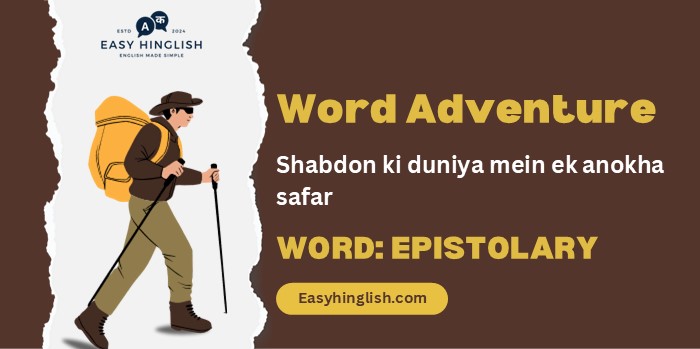Word Adventure: Epistolary
The Headline
“Letters Se Literature Tak: Kaise ‘Epistolary’ Ne Transform Kiya Storytelling Through Centuries”
The Scoop
Instant messaging aur email ke age mein, letter writing ki art ek relic of past lag sakti hai. Yet written correspondence ka influence hamari literature aur culture par profound remain karta hai. ‘Epistolary’ ek aisa word hai jo celebrate karta hai is influence ko aur remind karta hai humein ek time ka jab letters sirf communication nahi the but art form the. Chaliye explore karte hain ki kaise is concept ne shape kiya hai storytelling aur continue karta hai evolve hona hamari digital era mein.
Let’s Break It Down
The Plot Thickens
‘Epistolary’ ki journey through literary history utni hi fascinating hai jitni novels jo yeh describe karta hai. Though term khud English mein enter hua 17th century mein, practice of telling stories through letters dates back to ancient times. 1st century Rome mein, Ovid ki “Heroides” feature karti thi fictional letters from mythological heroines to their absent lovers.
Epistolary form ne apna golden age reach kiya 18th century mein works jaise Samuel Richardson ki “Pamela” (1740) aur “Clarissa” (1748), aur Jean-Jacques Rousseau ki “Julie, or the New Heloise” (1761) ke saath. In novels ne letters use kiye to create immediacy aur emotional intimacy, allowing readers to experience characters ki thoughts directly, without omniscient narrator intervening.
Jo cheez epistolary novels ko revolutionary banati thi woh thi unki ability to present multiple perspectives through different letter writers. Yeh technique create karti thi complex narrative webs, exploring subjective nature of truth itself. Yeh novels ko more accessible bhi banati thi women ke liye, both as readers aur writers, as letter-writing un few literary forms mein se ek thi jo deemed appropriate thi women ke liye us era mein.
While traditional epistolary novels decline hue 19th century mein, form never disappeared. Yeh simply evolve hua. Modern epistolary works incorporate karte hain emails, text messages, social media posts, aur other contemporary forms of correspondence. Alice Walker ki “The Color Purple” se le kar Maria Semple ki “Where’d You Go, Bernadette” tak, epistolary technique continue karti hai offer karna unique storytelling possibilities.
Word in the Wild
The Twist
Yahan kuch intriguing hai: while traditional epistolary novels decline hue hain, hum actually living kar rahe hain through renaissance of epistolary storytelling – though hum rarely recognize karte hain ise as such. Consider kijiye ki kitni modern stories unfold hoti hain through text messages, emails, blog posts, ya social media updates. Films like “Searching” tell karte hain apni stories entirely through digital screens. Video games like “Her Story” have players piece together narratives from fragmented video clips. Even reality TV often use karta hai “confessional” format jahan participants speak directly to camera – modern version of letter ki direct address. Epistolary impulse – to tell stories through direct, unmediated personal communication – remains utna hi powerful as ever; isme simply find kiye hain new vessels for expression!
Make It Stick
Epistolary: Jab stories unfold hoti hain one letter at a time, like whispers between confidants across the page!
Your Turn
Kya aapne kabhi epistolary novel padha hai ya movie dekhi hai jo told hai through letters, emails, ya text messages? Is format ne kaise affect kiya aapka experience of story? Ya perhaps aapne keep up kiya hai meaningful correspondence with someone in your own life? Share kijiye apne thoughts on epistolary communication – whether in literature ya life – comments mein below. Chaliye explore karte hain ki kaise yeh ancient form of expression continue karta hai connect karna humein!
Down the Rabbit Hole
- Classic epistolary novels ke baare mein curious hain? Explore kijiye “Dracula” by Bram Stoker, “Frankenstein” by Mary Shelley, ya “The Perks of Being a Wallflower” by Stephen Chbosky.
- Letter-writing as social practice ki history mein interested hain? Research kijiye ki kaise postal systems develop hue aur kaise unhone transform kiya communication aur literacy.
- Epistolary form ke modern adaptations discover karna chahte hain? Dekho web series like “The Lizzie Bennet Diaries” ya novels like “Attachments” by Rainbow Rowell jo use karte hain emails aur digital communication.
The Last Word
Jaise hum seal karte hain envelope on our exploration of ‘epistolary,’ main hope karta hoon ki aapne appreciation gain ki hai is word ke liye jo bridge karta hai centuries of human connection through written correspondence. Handwritten letters sealed with wax se le kar instant messages typed with thumbs tak, desire to share our stories directly, in our own voices, constant remain karta hai. Next time jab aap read karein novel of letters ya send karein important email, remember kijiye ki aap participate kar rahe hain is rich epistolary tradition mein jo shape kar raha hai literature aur lives for centuries. Until our next word adventure, yeh hoon main Prashant from Wordpandit, aap sabko encourage karta hoon ki write kijiye apni own story, one message at a time!








